Study on the medication rules of traditional Chinese medicine in the treatment of sleep disorder after stroke based on data mining
Xian Liu, Jia-Xin Jin, Li-Li He, Peng-Zhen Ma, Su-Su Ma, Yu-Xuan Du, Ying-Zhen Xie
Dongzhimen Hospital,Beijing University of Chinese Medicine,Beijing 100700,China
Keywords:Data mining Sleep disorder after stroke Medication rule Association analysis Clustering analysis
ABSTRACT Objective: To explore the medication rule of Traditional Chinese Medicine(TCM) in the treatment of sleep disorder after stroke by using data mining technology. Methods: A computer search was used to search the electronic database of clinical literature on the treatment of sleep disorders after stroke by TCM from January 2000 to January 2021. Excel was used to establish the database, and the prescription information was described and analyzed statistically. Using IBM SPSS Modeler 18.0 software, Apriori algorithm was used for TCM association analysis, and IBM SPSS 22.0 software was used for systematic cluster analysis of high‑frequency TCM. Results: A total of 67 literatures were included, covering 131 traditional Chinese medicines.The medecines with a higher frequency of sodium use include Ziziphi Spinosae Semen(Suanzaoren), Angelicae Sinensis Radix(Danggui), Ligusticum(Chuanxiong), liquorice(Gancao), Poria cocos(Fuling), and so on. From the effect point of view, deficiency‑tonifying medicine, sedative medicine and blood‑activating and stasis‑removing medicine are commonly used. The medicinal properties are mainly cold, mild and warm. The main medicine flavor are sweet and bitter. The medicines mostly belong to the liver,heart and spleen Meridian. Thirty‑three association rules were obtained for medicine pairs and medicine groups from the correlation analysis, and the core combinations were "Ziziphi Spinosae Semen(Suanzaoren)‑Tuber fleeceflower stem(Yejiaoteng)", "Ziziphi Spinosae Semen (Suanzaoren)‑Polygala(Yuanzhi)", "Ziziphi Spinosae Semen(Suanzaoren)‑Cortex albiziae(Hehuanpi)" and "Angelicae Sinensis Radix(Danggui)‑Radix bupleuri(Chaihu)‑Radix Paeoniae Alba(Baishao)" and so on. Seven medicine aggregation groups were obtained by medicine cluster analysis. Conclusion: In the treatment of sleep disorder after stroke by TCM,the main method is to calm the heart and mind. Meanwhile, according to different syndrome types, the treatment methods of tonifying the heart and spleen, nourishing the liver and kidney,soothing the liver and softening the liver, clearing heat and resolving phlegm, nourishing the blood and promoting blood circulation are selected, which provide certain reference for clinical treatment.
1. Introduction
Stroke is characterized by a high morbidity, disability and recurrence rate[1-2], which seriously threatens the life and health of stroke patients. Sleep disorders are one of the common complications in stroke patients, and it has been reported that the incidence of post‑stroke sleep disorders (PSSD) is about 76%~82%[3]. Its main manifestations include difficulty in falling asleep, decreased total sleep time, excessive sleep, sleep disordered breathing, and mental symptoms after sleep[4-5], which has a serious adverse effect on the recovery of neurological function and prognosis of patients[6-8]. TCM has advantages of good efficacy,fewer side effects and multiple targets for the treatment of sleep disorders after stroke [9], which can significantly improve the clinical symptoms of patients and improve the quality of life of patients. This paper collected and sorted out the relevant literatures on the treatment of sleep disorders after stroke by TCM in the past 20 years, and explored the compatibility rules of its prescriptions, in order to provide ideas for the treatment of sleep disorders after stroke by TCM.
2. Information and methods
2.1 Literature sources
In this study, Cochrane Library, PubMed, Embase, CNKI, Wanfang Database and VIP were used as search sources. The English search terms were "stroke", "apoplexy", "cerebrovascular disease","insomnia", "Sleep disorders" and "traditional Chinese medicine".The Chinese search terms were "stroke", "cerebrovascular disease","insomnia", "sleep disorder" and "traditional Chinese medicine". The retrieval period is from January 2000 to January 2021.
2.2 Literature inclusion criteria
(1) The subjects of the study were clinical patients with internationally or domestically recognized clinical diagnostic criteria; (2) Oral administration of TCM compound was the main intervention measure; (3) Randomized controlled clinical trial(RCT) was conducted with a sample size of ≥30 patients and the efficacy was definite; (4) Complete records of the taste and dosage of Chinese medicine in the selected prescription.
2.3 Literature exclusion criteria
(1) The study subjects had no clear diagnostic criteria; (2)Literature on topical use of TCM, medicine oxygen and injection as main intervention measures; (3) Literature of unclear composition and dosage of prescription; (4) Retrospective studies, case reports,literature reviews, animal or cell experimental studies, medical case summaries and other non‑clinical research literature; (5) Random grouping is not indicated; (6) Only one paper was included in the paper for multiple doses or for prescriptions with the same composition of medicine taste.
2.4 Data preprocessing
2. 4. 1 Standardization of dataThe names of traditional Chinese medicines are standardized in accordance with the "Pharmacopoeia of the People's Republic of China"[10] and the "Thirteenth Five‑Year Plan" textbook "Chinese Materia Medica"[11] for higher schools of Chinese medicine across the country, such as "guiyuanrou" unified as "longan aril", "radix polygoni multiflori vine" unified as "Fleeceflower stem", and so on. If there are different processing methods but similar effects of Chinese medicine, the original name is recorded, such as Pao Radix Aconiti and Zhi Radix Aconiti are unified as Radix Aconiti; Fa Pinellia, Qing Pinellia and Jiang Pinellia are unified as Pinellia.
2.4.2 Establishment of database
According to the inclusion standard, the literature was independently screened by two people, and the prescriptions that met the requirements were input into the Microsoft Excel 2019 worksheet, so as to establish the prescription database. The field of Chinese medicine is treated by binary quantization. The presence of this medicine is marked as "1", and the absence of this medicine is marked as "0". In order to ensure the authenticity and reliability of the data, the data of this study were recorded by two people respectively and sent to the third party for review and proofreading to ensure the accuracy of the data.
2.5 Statistical Methods
Excel was used to describe and statistically analyze the frequency of medicine use, efficacy category, and sexual taste conversion in the data. The IBM SPSS Modeler 18.0 software was used to draw the network diagram of TCM association analysis, and the Apriori algorithm was used to conduct TCM association analysis with the support degree ≥13% and confidence degree ≥80% as the criteria,and the sample groups that fit the minimum support threshold and minimum trust threshold at the same time were found out. IBM SPSS 22.0 software was used to carry out systematic cluster analysis on the top 30 traditional Chinese medicines in frequency of use.According to their quantitative characteristics, they were classified according to the degree of similarity.
3. Results
A total of 347 literatures were retrieved, and the title was imported into Note Express 2.0 software, 86 repeated literatures were screened out, and 145 studies on summaries of medical cases, animal experiments and non‑orally administered medicine therapy of TCM were eliminated by reading abstracts and titles. The remaining 116 literatures that met the requirements were downloaded for full text reading. A total of 49 literatures were excluded, including unclear diagnostic criteria, non‑random grouping, incomplete composition of medicine and taste, and multiple literatures using the same prescription. After repeated review, 67 literatures finally met the requirements.
3.1 Frequency of medicines
Among the 67 included literatures, a total of 69 prescriptions were involved, covering 131 traditional Chinese medicines, with a total frequency of 766 times. According to the frequency of occurrence,from high to low, the top 30 Chinese medicines are listed in Table 1.
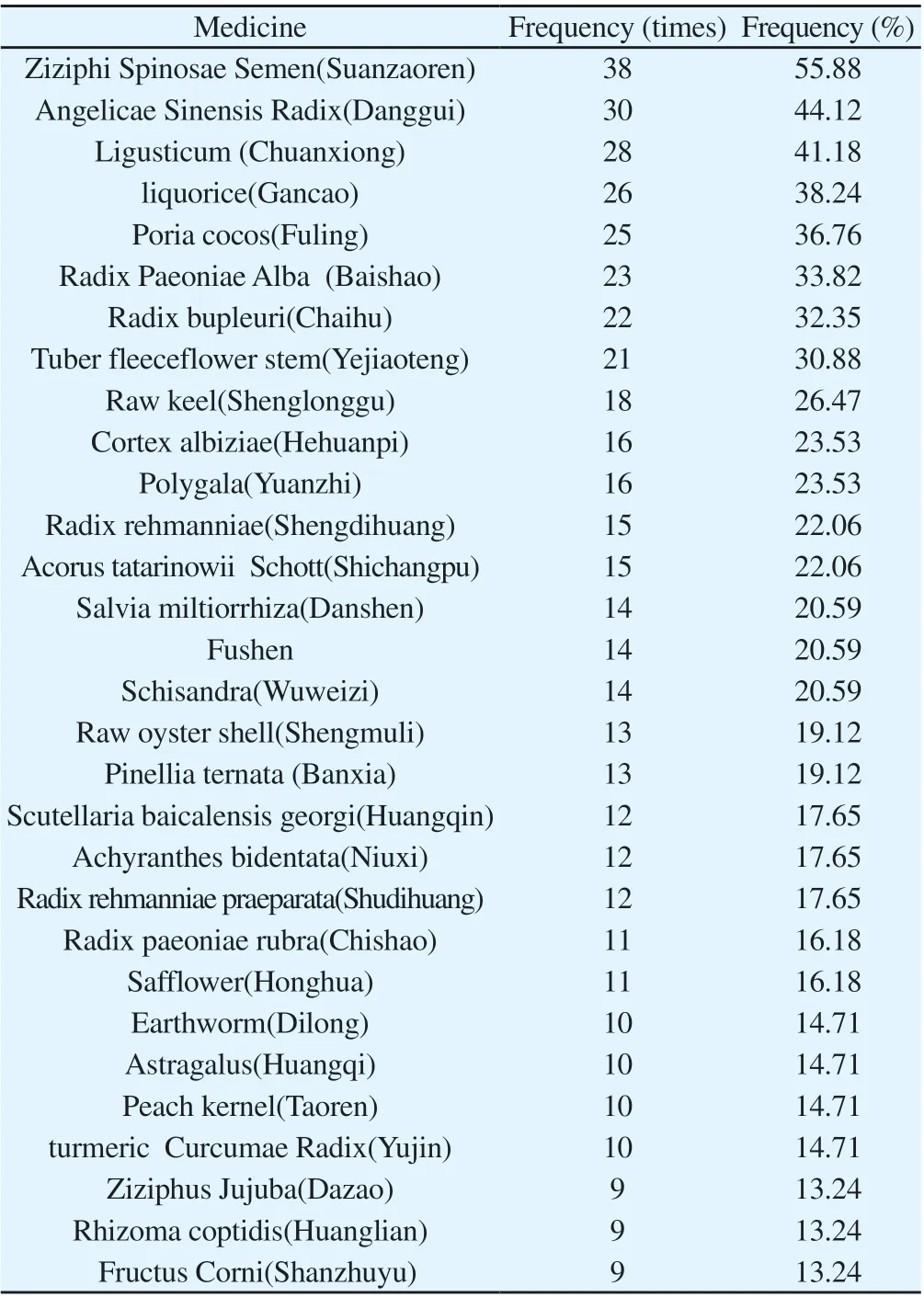
Table 1 Frequency statistics of the top 30 Chinese medicines.
3.2 Frequency statistics of efficacy of TCM
《Chinese Medicine》, the textbook for the 13th Five‑year Plan of Chinese Medical Colleges and Universities, classifies the efficacy of TCM into 21 categories, and ranks them according to the frequency of use (the total number of times a certain type of medicine appears in the prescription) and frequency (the ratio of the frequency of a certain type of Chinese medicine to the total frequency of Chinese medicine) of each type of medicine. The results showed that the total frequency of use was 766 times, among which the five kinds of traditional Chinese medicines that were used most frequently were medicines of tonifying deficiency (198 times,25.85%),medicines of tranquilizing medicines (139 times, 18.15%),medicines of promoting blood circulation and removing blood stasis(95 times, 12.40%),medicines of clearing heat (80 times, 10.44%),and medicines of calming the liver and alleviating wind (45 times,5.87%). The cumulative frequency of use was 72.72%, as shown in Table 2.
3.3 Statistics on medicinal properties of traditional Chinese medicines
Traditional Chinese medicine can be divided into five categoriesaccording to their properties: cold, hot, warm, cool and mild, each of which has a specific property. The total frequency of 131 medicines was 766 times. medicines were mainly cold, mild and warm medicines, among which cold medicines were 252 times, accounting for 32.90%; mild medicines were 251 times, accounting for 32.77%;warm medicines were 249 times, accounting for 32.51%; cool medicines were 8 times, accounting for 1.04%; hot medicines were the least, 6 times, accounting for 0.78%. The results are shown in Figure 1.
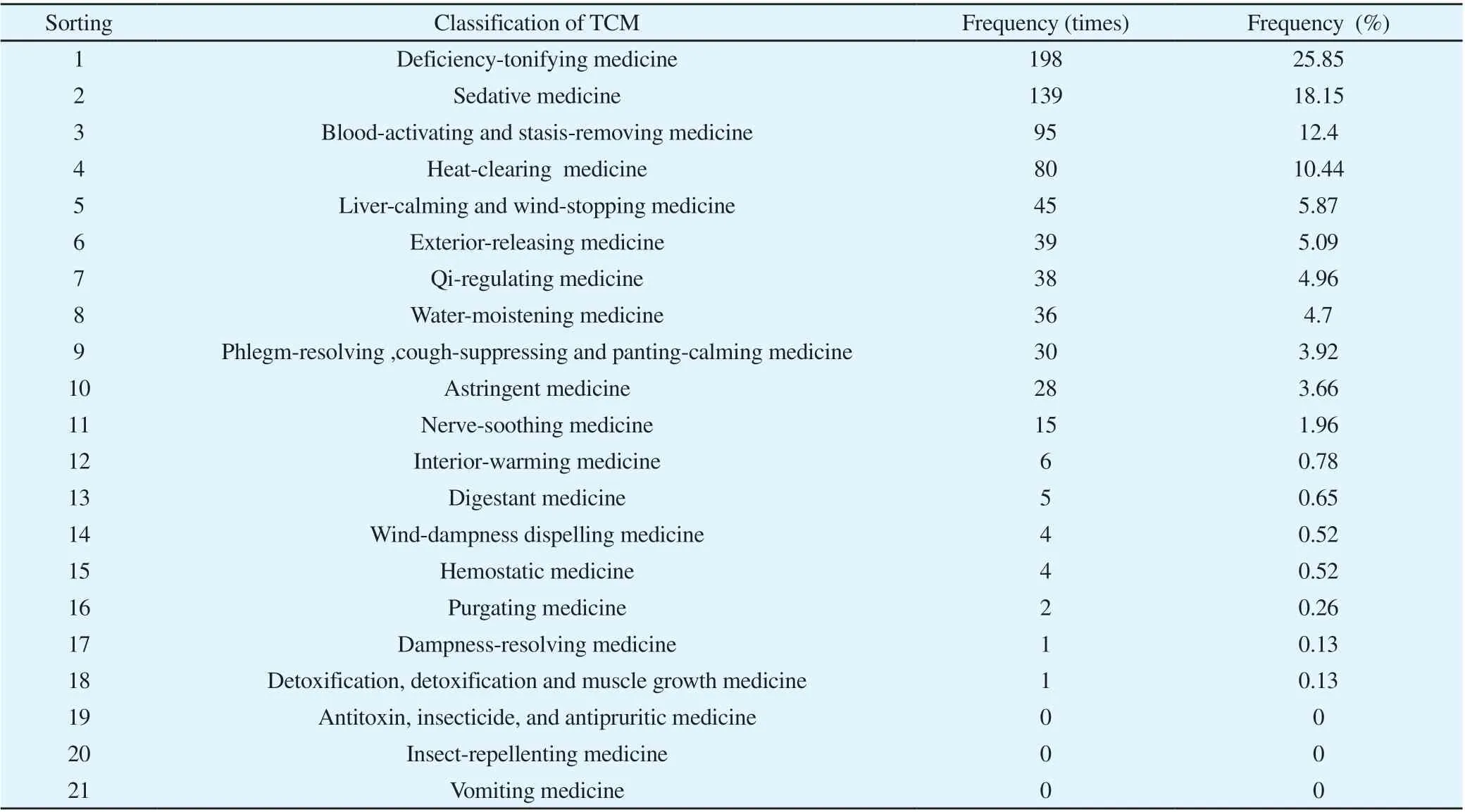
Table 2 Statistics of categories of TCM used in the treatment of sleep disorders after stroke.
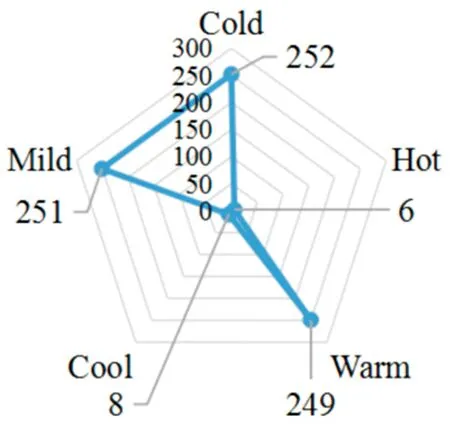
Figure 1 Frequency diagram of the properties of TCM
3.4 Statistics of TCM medicinal tastes
Traditional Chinese medicine can be divided into seven kinds according to its tastes: sour, bitter, sweet, pungent, salty, weak,astringent. Each kind of traditional Chinese medicine can correspond to a variety of tastes. The total frequency of 131 traditional Chinese medicines was 1199 times. Among them, sweet taste were the main ones, with a frequency of 445 times, accounting for 39.77%,followed by bitter taste, with a frequency of 280 times, accounting for 25.02%, pungent taste, with a frequency of 234 times, accounting for 20.91%, sour taste, with a frequency of 112 times, accounting for 10.01%, weak taste, with a frequency of 48 times, salty taste, with a frequency of 47 times, accounting for 4.20%, and astringent taste,with the least. 33 frequency, accounting for 2.95%. As shown in figure 2.
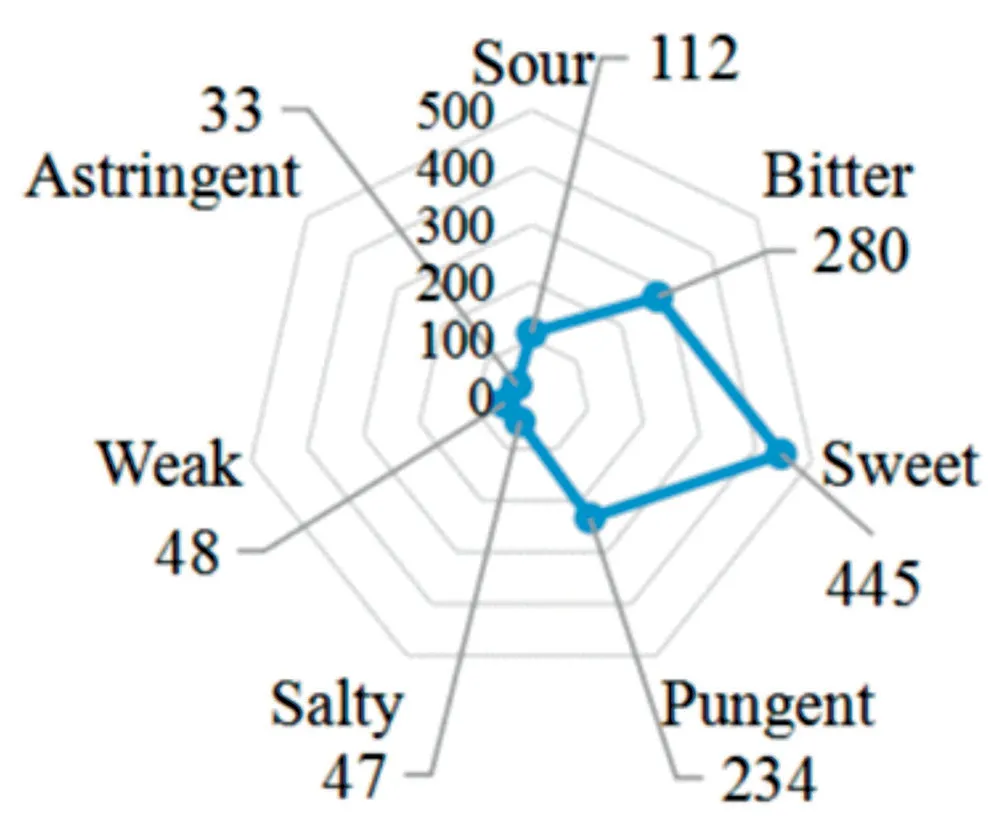
Figure 2 Frequency diagram of five tastes of traditional Chinese medicine
3.5 Statistics on the meridians tropisms of TCM
According to the theory of Zangxiang and meridians, each traditional Chinese medicine can be classified into multiple meridians. The total frequency of 131 TCM meridians was 2901 times. The top 3 frequencies of meridians were: liver meridians (460 times,22.00%), heart meridians(398 times,19.03%), spleen meridians(287 times,13.73%), lung meridians (262 times,12.53%), and other meridians frequencies were all less than 10%, as shown in Figure 3.
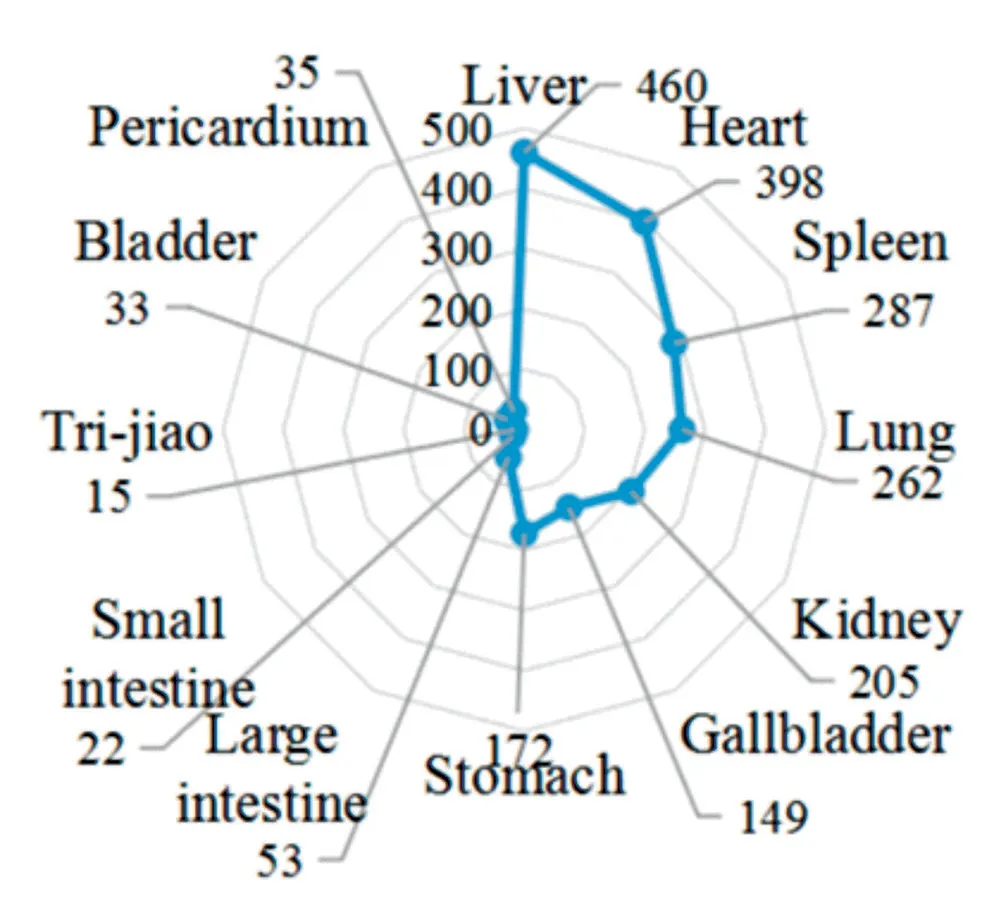
Figure 3 Frequency diagram of the meridians tropisms of TCM
3.6 Association rule analysis
IBM SPSS Modeler 18.0 software was used to analyze the included TCM, and a network diagram of TCM association rules was obtained, as shown in Figure 4. Apriori algorithm was used to set the"minimum condition support" of 13%, "minimum rule confidence"of 80%, and the maximum number of previous items of 3. The two‑item, three‑item and four‑item association analysis was conducted respectively, and 33 association rules were obtained for medicine pairs and medicine groups. The results were shown in Table 3, Table 4, and Table 5.
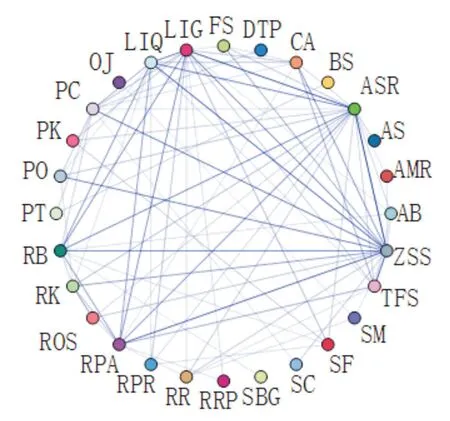
Figure 4 Network diagram of association rules of TCM
3.7 Cluster analysis
SPSS Statistics 22.0 was used for systematic cluster analysis of the top 30 Chinese medicines in frequency. The clustering results are shown in Figure 5 and Table 6.
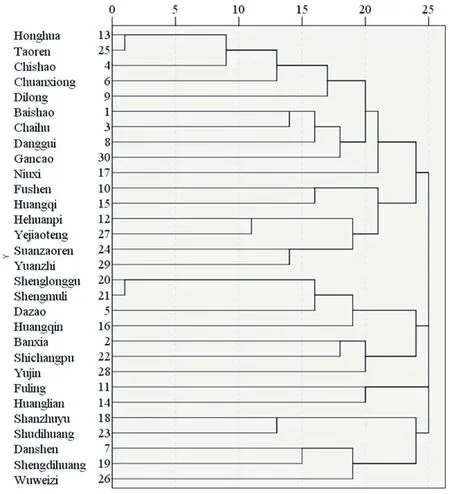
Figure 5 Tree diagram of cluster analysis of high‑frequency medicines in the treatment of post‑stroke sleep disorders by TCM
4. Discussion
Sleep disorders belong to the category of "insomnia" and"hypnotism" in traditional Chinese medicine, and their pathogenesis is mainly the imbalance of visceral qi in Yingwei, the disorder of qi and blood, and the division of mental displacement [12]. "Lingshu· Big Confusion" : "Wei Qi...... Not to enter the Yin is Yin Qideficiency, so the eye is not resplendent." Lingshu Cold and Heat Disease says, "If Yang Qi is strong, anger shows eyes; if Yin Qi is strong, close eyes" [13]. It shows that the normal operation of Yingwei and the harmonization of Yin and Yang are the basis for the formation of sleep, and if the operation of Yingwei is abnormal, Yang does not enter Yin, it will cause sleep disorders. Some scholars believe that the common etiology and pathogenesis of stroke and post‑stroke sleep disorders are the impaired function of viscera caused by old age, imbalance of work and rest, emotional incompatibility or exogenous evil spirits [14]. Therefore, the corresponding treatment principles are tonifying deficiency and reducing reality, harmonizing Yingwei and balancing Yin and Yang. Modern studies have shown that the occurrence of sleep disorders after stroke is associated with 5‑hydroxytryptamine (5‑HT), norepinephrine (NE), γ‑aminobutyric acid (GABA), melatonin and other neurotransmitters secretion disorders and transmission disruption[15-19]. In addition,psychosocial factors such as anxiety and depression in patients after stroke are also important factors affecting sleep [20].

Table 3 Analysis results of two‑item association rules of TCM
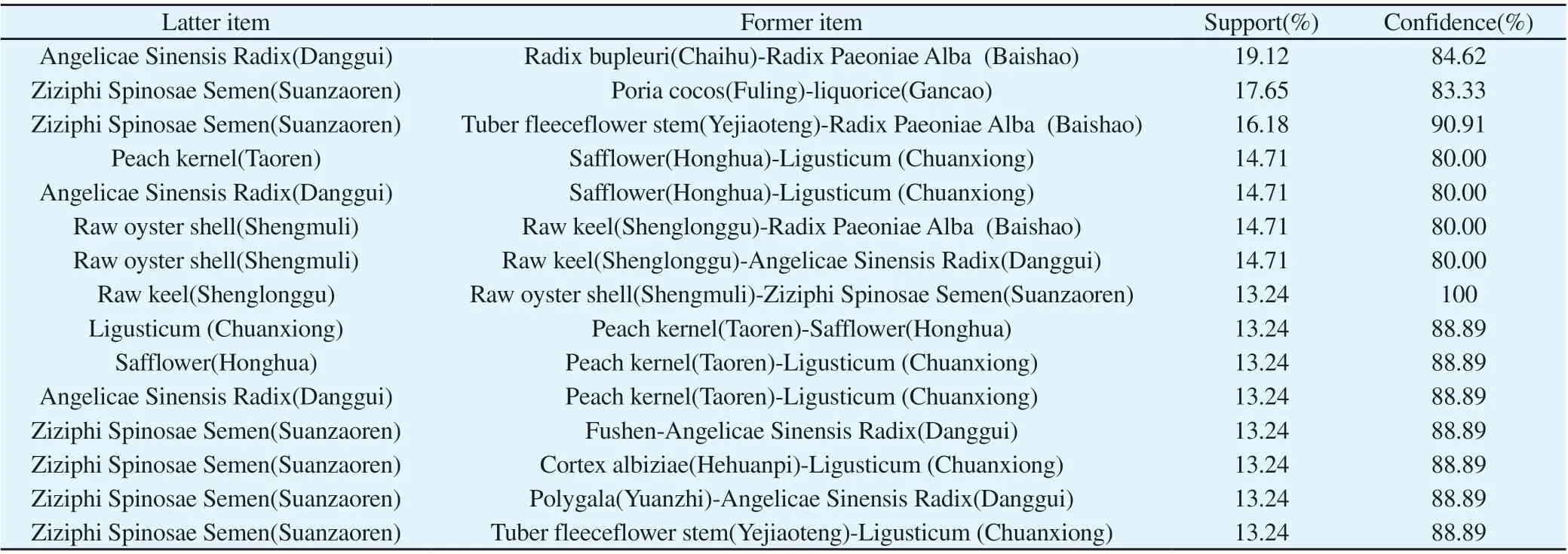
Table 4 Analysis results of three‑item association rules of TCM

Table 5 Analysis results of four‑item association rules of TCM
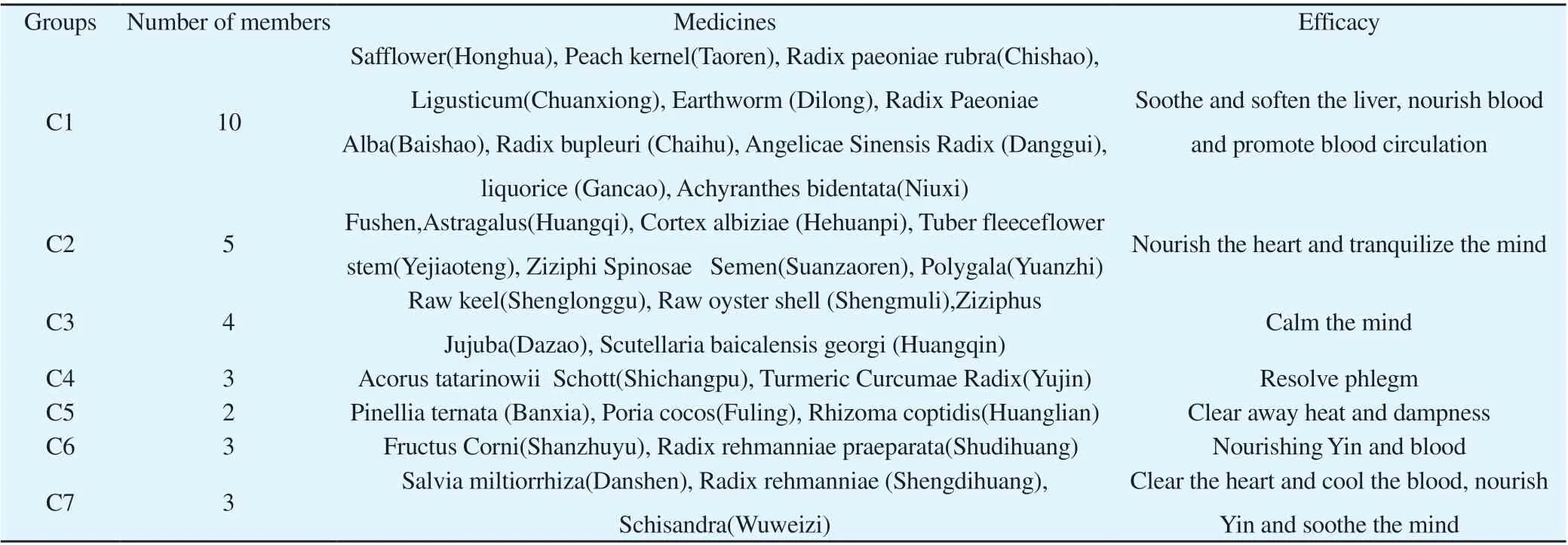
Table 6 Cluster analysis of the top 30 Chinese medicines
4.1 Analysis of frequency, efficacy, taste and meridian of TCM in the treatment of sleep disorders
The high frequency medicines of TCM in the treatment of sleep disorders after stroke mainly include Ziziphi Spinosae Semen(Suanzaoren), Angelicae Sinensis Radix(Danggui),Ligusticum (Chuanxiong), liquorice(Gancao), Poria cocos(Fuling),Radix Paeoniae Alba (Baishao), Radix bupleuri(Chaihu),Tuber fleeceflower stem(Yejiaoteng),Raw keel(Shenglonggu), Cortex albiziae (Hehuanpi) and so on. Ziziphi Spinosae Semen(Suanzaoren)and Tuber fleeceflower stem (Yejiaoteng) can nourish the mind and soothe the nerves. Angelicae Sinensis Radix(Danggui) and Ligusticum (Chuanxiong) can nourish blood and activate blood.Liquorice(Gancao) and Poria cocos(Fuling) can invigorate the spleen and nourish qi. Radix bupleuri(Chaihu) can soothe the liver and relieve depression. Radix Paeoniae Alba(Baishao) can restrain Yin and soften the liver. Raw keel(Shenglonggu) can calm the mind. Cortex albiziae(Hehuanpi) can relieve depression and soothe the mind. Among them, Ziziphi Spinosae Semen(Suanzaoren)and Angelicae Sinensis Radix(Danggui) were the most frequent medicines. From the perspective of efficacy, the medicines of replenishing deficiency and calming the mind are used mostly.It can be seen that deficiency of heart blood is the main internal factor of sleep disorders, and treatment methods such as nourishing blood and calming the mind should be paid attention to. From the medicinal property, cold, mild, and warm medicines are used, and the proportion of the three types of medicines is roughly the same.[21] In Lingshu · On Big Confusions, it is said: "Wei Qi cannot enter Yin; if it stays in Yang, Yang will be full; if Yang is full,Yangqiao medirian will be full; if it does not enter Yin, Yin will be weak; therefore, people will not sleep." In the treatment of sleep disorders after stroke, cold ,warm and mild medicines were used and corresponding medicines were selected according to Yin and Yang's partial success and partial decline. From the point of view of medicine taste, sweet and bitter medicines are commonly used ,because sweet taste has nourishing, harmonizing, and moistening functions. Bitter taste has the functions of clearing away dampness and purging. And the combination of the two can have the effect of reinforcing deficiency and reducing reality. According to the results of traditional Chinese medicine, the medicines that treat sleep disorders mostly belong to the liver, heart and spleen Meridian.The liver governs venting, the heart holds the spirit, and the spleen governs movement and transformation. If the emotions are uncomfortable, it can cause liver failure and Qi stagnation over time.Because of old age and physical weakness, spleen will be weak, and movement and transformation of Qi is unbalanced, resulting in turbid phlegm. Over time, the phlegm will produce heat, which will disturb the mind and become insomnia[22]. Therefore, sleep disorders can be treated from nourishing the heart, soothing the liver, strengthening the spleen and soothing the nerves.
4.2 Analysis of high-frequency medicine pairs of TCM in the treatment of sleep disorders
The results of the Chinese medicine association rules show that, among the two‑item association rules, the support for the combination of "Ziziphi Spinosae Semen(Suanzaoren)‑Tuber fleeceflower stem(Yejiaoteng)", "Ziziphi Spinosae Semen(Suanzaoren)‑Polygala(Yuanzhi)", "Ziziphi Spinosae Semen(Suanzaoren)‑Cortex albiziae(Hehuanpi)" is the highest,and among the three‑item association rules, "Angelicae Sinensis Radix(Danggui)‑Radix bupleuri (Chaihu)‑Radix Paeoniae Alba(Baishao)" Chinese medicine combination has the highest support, and the four‑item association rules take "Angelicae Sinensis Radix(Danggui)‑Radix bupleuri (Chaihu)‑Radix Paeoniae Alba(Baishao)‑Ligusticum (Chuanxiong)" as the main combination.Ziziphi Spinosae Semen(Suanzaoren), Tuber fleeceflower stem(Yejiaoteng),Cortex albiziae (Hehuanpi) and Polygala(Yuanzhi)enter the heart meridian, which has the effect of calming the heart and soothing the nerves. They can be used for insomnia caused by yin and blood deficiency. Angelicae Sinensis Radix(Danggui) enters the heart and liver meridian, which can nourish blood and activate blood. Radix bupleuri(Chaihu) and Radix Paeoniae Alba (Baishao)enters the liver meridian,which can soothe the liver and soften the liver. The medicines above work together to nourish the heart and soothe the liver to soothe the nerves. And they can be used for insomnia caused by liver stagnation and qi stagnation. In addition, in other association rules, the combination of invigorating the spleen,nourishing the heart and calming the nerves is "Ziziphi Spinosae Semen(Suanzaoren)‑Poria cocos(Fuling)‑liquorice(Gancao)".The combination of tranquillity is "Raw keel(Shenglonggu)‑Raw oyster shell(Shengmuli)". The combination of nourishing blood and promoting blood circulation is "Angelicae Sinensis Radix(Danggui)‑Safflower(Honghua)‑Ligusticum (Chuanxiong)".They are also commonly used. In summary, the analysis of the medicine pair shows the structure of Suanzaoren Decoction, Guipi Decoction and Xiaoyao Powder. It can be seen that Ziziphi Spinosae Semen(Suanzaoren) is the core medicine in the treatment of sleep disorders. Modern researches[23-25] show that Ziziphi Spinosae Semen(Suanzaoren) saponins show significant activity in sedative,anti‑anxiety, and anti‑depressive aspects. The extract of Tuber fleeceflower stem(Yejiaoteng) has a nerve inhibitory effect and can improve the ultrastructure of mitochondria, which can significantly shorten the sleep latency, thereby improving sleep [26-27]. Extracts such as Cortex albiziae(Hehuanpi) and Polygala(Yuanzhi) have sedative, hypnotic, anti‑anxiety and depression effects [28-29].
4.3 Cluster analysis of TCM treatment of sleep disorders
According to cluster analysis, the top 30 traditional Chinese medicines with medicine frequency were clustered into 7 groups. C1: Safflower(Honghua),Peach kernel(Taoren),Radix paeoniae rubra(Chishao),Ligusticum (Chuanxiong),Earthworm(Dilong),Achyranthes bidentata (Niuxi) and Angelicae Sinensis Radix(Danggui) nourish blood, promote blood circulation and remove blood stasis. Radix Paeoniae Alba (Baishao) and Radix bupleuri(Chaihu) soothe the liver and soften the liver.Liquorice(Gancao) strengthens the spleen and invigorates qi.All herbs are used together to play the effect of soothing the liver and softening the liver, nourishing blood and promoting blood circulation,and the meaning of Xuefu Zhuyu Decoction can be used for sleep disorders of qi stagnation and blood stasis.C2:Fushen,Astragalus(Huangqi), Cortex albiziae (Hehuanpi),Tuber fleeceflower stem(Yejiaoteng),Ziziphi Spinosae Semen (Suanzaoren)and Polygala(Yuanzhi)all have the effect of nourishing the heart and tranquilizing the mind. They reflect the meaning of Guipi Decoction and suitable for the patients with deficiency of the heart and spleen.C3:Raw keel(Shenglonggu) and Raw oyster shell(Shengmuli) can calm the liver and yang, soothe the nerves. Ziziphus Jujuba(Dazao)can nourish blood and soothe the nerves. Scutellaria baicalensis georgi(Huangqin) clears the heat. They mean the addition and subtraction of Chaihulongmu soup and have the effect of soothing the nerves and venting heat, which are suitable for those who disturb the liver yang. C4 : The combination of Pinellia ternata(Banxia),Acorus tatarinowii Schott(Shichangpu) and Turmeric Curcumae Radix(Yujin) has the function of promoting Qi and resolving phlegm, which is suitable for people with Qi stagnation and phlegm obstruction. C5: Poria cocos(Fuling) invigorates spleen and calves the mind, and Rhizoma coptidis(Huanglian) clears heat of heart. The combination of two medicines can replenish deficiency and reduce compactness. It has the effect of clearing heat,invigorating spleen and calming the mind, and is suitable for those with spleen deficiency and heart fire. C6: Fructus Corni(Shanzhuyu)and Radix rehmanniae praeparata(Shudihuang) can nourish Yin and blood, and tonify liver and kidney, which are suitable for people with deficiency of liver and kidney Yin. C7:Salvia miltiorrhiza(Danshen)and Radix rehmanniae(Shengdihuang) can clear the heart,cool the heart Blood, remove troubles and soothe the nerves.Schisandra(Wuweizi) nourishes the heart and kidney, calms the heart and soothes the nerves. The combination of them can clear the heart and cool the blood, nourish the yin and soothe the nerves,which are suitable for insomnia caused by the deficiency of heart and yin.
To sum up, this study explored the rules of traditional Chinese medicine in the treatment of sleep disorders after stroke through data mining method, which was more in line with the understanding of physicians of previous dynasties on this disease. The main treatment of traditional Chinese medicine for this disease is to calm the heart and calm the nerves. At the same time, according to the different types of syndromes, the corresponding treatment methods are used,which provides a certain reference for clinical treatment.
Author's contribution
The first author, Liu Xian, was responsible for determining the search terms, literature retrieval, screening, data collection and processing, and paper writing.Jin Jiaxin was responsible for the retrieval, screening and data collection of articles, and participated in the collection and analysis of data.He Lili and Ma Pengzhen participated in data collection and analysis, and were responsible for the improvement and modification of the article content.Ma Susu and Du Yuxuan were responsible for the retrieval, screening, data collection and information verification of the articles.Corresponding author, Xie Yingzhen was responsible for the topic selection, design and review of the paper.
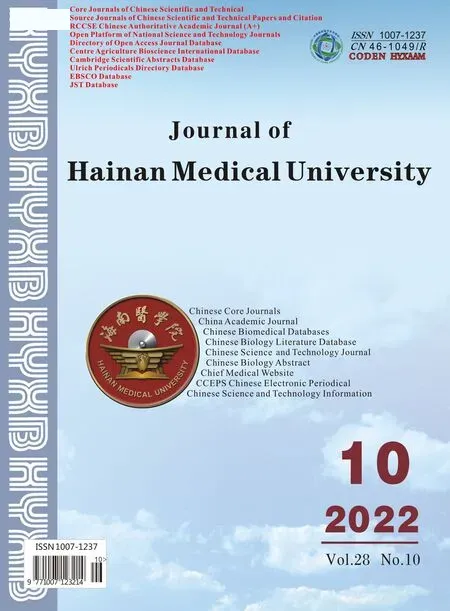 Journal of Hainan Medical College2022年10期
Journal of Hainan Medical College2022年10期
- Journal of Hainan Medical College的其它文章
- Intervention effect and mechanism of Jisheng Shenqi Decoction plus Panax notoginseng and Bionjia on CCl4-induced hepatic fibrosis rat model
- Effects of acupuncture combined with Kaijingtongmai Decoction on ATP sensitive potassium channel related proteins Kir6.1 and Kir6.2 in myocardial infarction rats
- Exploring the molecular biological mechanism of Shugan Jianpi Decoction in the treatment of depression-related breast cancer based on network pharmacology
- Clinical effect of enriching qi, activating blood circulation, clearing away dampness and heat combined with western medicine in the treatment of idiopathic membranous nephropathy: A meta-analysis
- Effects of LPS-induced cholangitis on the cytoskeleton morphology of bile duct epithelium and the intervention mechanism of Dahuang Lingxian formula for these changes
- Effects of stress of different duration on depression-like behavior and expression of CB1 and GluA1 in medial prefrontal cortex of rats
